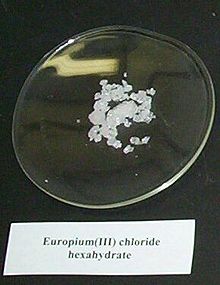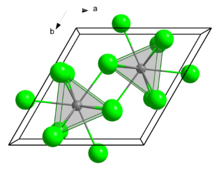
| |

| |
| Names | |
|---|---|
| IUPAC names
Europium(III) chloride
Europium trichloride | |
| Identifiers | |
| |
3D model (JSmol)
|
|
| ChemSpider | |
| ECHA InfoCard | 100.030.025 |
| EC Number |
|
PubChem CID
|
|
| RTECS number |
|
| UNII | |
CompTox Dashboard (EPA)
|
|
| |
| |
| Properties | |
| EuCl3 | |
| Molar mass | 258.323 g/mol 366.41 g/mol (hexahydrate) |
| Melting point | 632 °C (1,170 °F; 905 K) decomposes |
| Solubility in other solvents | Soluble |
| Structure | |
| hexagonal (UCl3 type), hP8 | |
| P63/m, No. 176 | |
| Tricapped trigonal prismatic (nine-coordinate) | |
| Related compounds | |
Other anions
|
Europium(III) oxide |
Other cations
|
Samarium(III) chloride Gadolinium(III) chloride |
Related compounds
|
Europium dichloride |
Except where otherwise noted, data are given for materials in their standard state (at 25 °C [77 °F], 100 kPa).
| |
Europium(III) chloride is an inorganic compound with the formula EuCl3. The anhydrous compound is a yellow solid. Being hygroscopic it rapidly absorbs water to form a white crystalline hexahydrate, EuCl3·6H2O, which is colourless. The compound is used in research.
